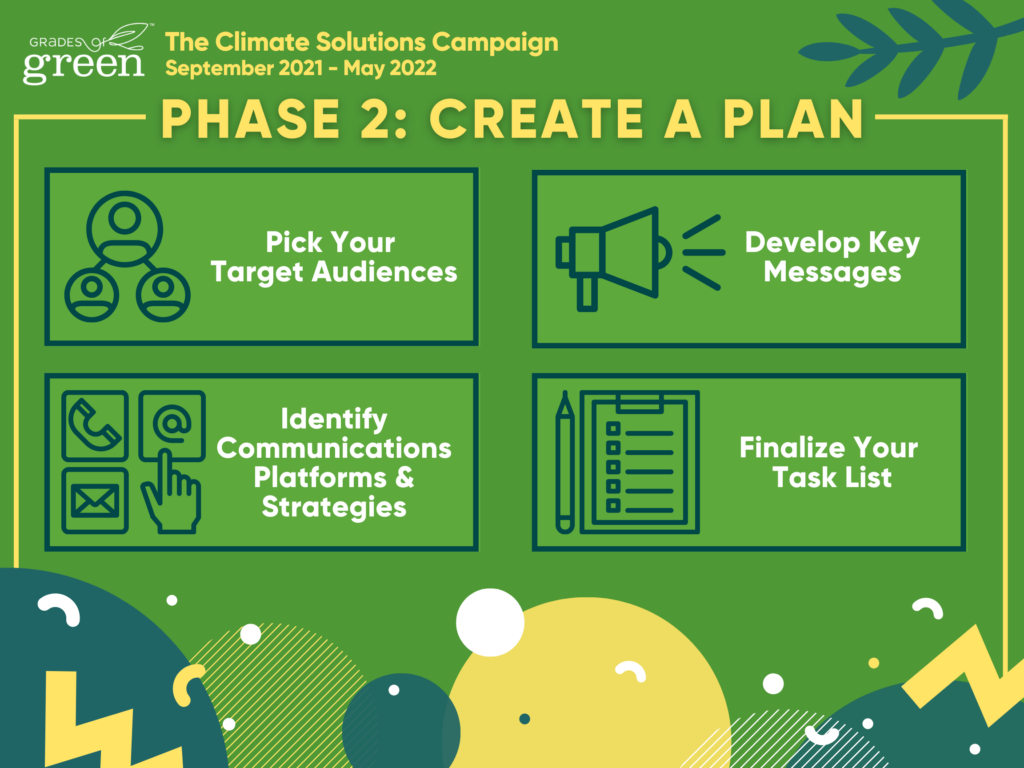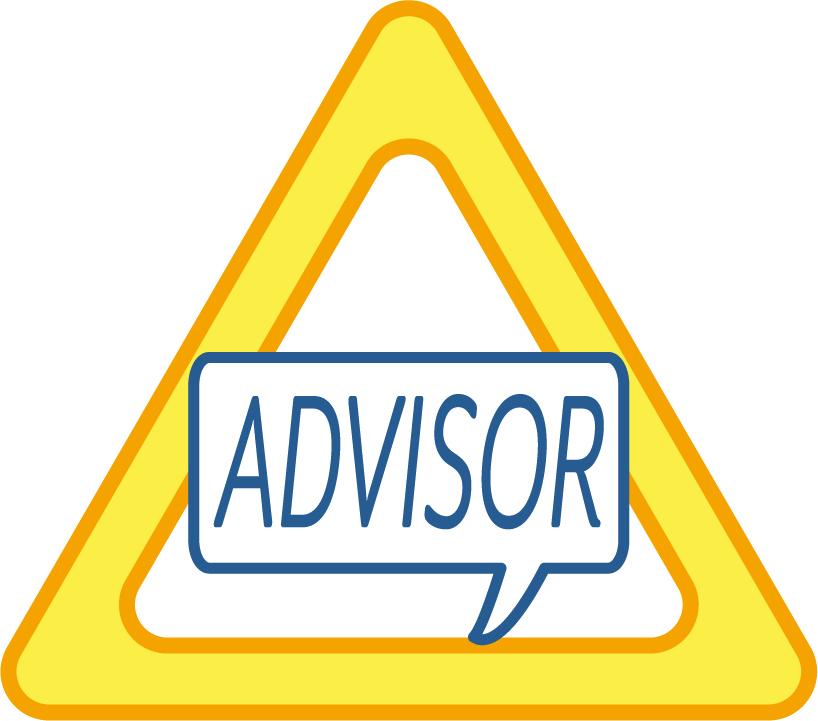Way to go – you picked your project and established your goal! During this phase, you will create a plan to take your Campaign from a project idea to a real climate solution.
The Campaign Path: Phase 2

The Campaign Path: Phase 2 – Create a Plan
- ✅ Pick your target audiences. Complete “Phase 2.1 – Target Audience” questions.
- ✅ Develop Key Messages for your Campaign. Complete “Phase 2.2– Key Messages” questions.
- ✅ Determine important parts of your Campaign. Complete the “Phase 2.3 – Communication Platforms & Strategies” questions.
- ✅ Finalize your task list. Complete the “Phase 2.4 – Task List” questions.
- Check in with Advisor.
Why Pick a Target Audience?
Everyone is unique! It’s no surprise that everyone has different opinions about what is and isn’t important. Even people who agree that we need to take action to fix the climate crisis have different ideas of what to prioritize and what those changes should be.
When you ask someone to take action, you should craft a message that highlights things that are important to them. People pay more attention to things they find familiar, relevant, and important. We do this by identifying a group of people called a “target audience.” The target audience(s) your team chooses for your project will be based on the campaign type you chose in Phase 1.3 .
Target Audience Definition:
A group of individuals who have something in common. Used by communicators when crafting a message.
Picking Your Target Audiences
So you’ve learned what a target audience is and why it’s important. Now it’s time to figure out who your target audience is based on your campaign type. You should only have one or two target audiences for your campaign. Having just one target audience is perfectly fine!
Your first step: Click on the campaign type you have chosen to learn more!
🔊 – Public Education & Action Campaign
The key to picking a target audience for a Public Education Campaign is to get specific. This will help you narrow down what to say when you’re developing key messages.
Review the points below with your team to help define your target audience(s). Contact your Advisor for help!
- Start with your project’s call to action.
- It may seem obvious, but your target audience could just be the people who have the habit you want to change! For example, if you want people who drive gas-powered vehicles to switch to electric, your target audience is probably “gas-powered car drivers.”
- Pick a target audience that is easy for you to reach, then figure out what they have in common.
- If you have an email list or social media account that you know you’ll be using, this is a great place to start.
🏢 – Institutional Change Campaign
There are two main audiences for the Institutional Change Campaign: the decision maker(s) and their stakeholders. Depending on your project, you’ll either target one or both of these groups.
Decision Makers: Your most important audience is the decision maker (or makers) for the institution. These are the people in charge of setting the policies that the institution follows. Sometimes an institution has multiple types of decision makers that share responsibility, like a school district’s superintendent and school board.
Examples:
- For Cities: Mayor and/or City Council
- For School Districts: Superintendent, School Board Members, and/or the PTA.
- For Businesses: Owner, CEO, and/or Regional Manager.
Stakeholders: The second audience, the “stakeholders,” are made up of people that matter the most to the decision makers you’re trying to influence. They can be the people that the institution depends on to exist. If you can show that the majority of stakeholders support your project, then the decision makers are much more likely to agree with you.
Examples:
- For schools and school districts: Funders, parents and students.
- For governments: The voters, community members, and businesses that pay taxes.
- For Businesses: Customers.
To help you pick your target audience(s), review the following questions with your team. Not sure or feeling stuck? Please contact your Advisor for help!
- Will you be targeting your institution’s decision makers AND its stakeholders, or just one of these groups?
- If your project is to make a really big change to the institution, it probably makes sense to focus on the stakeholders first so that you can build support for your change within the institution.
- If you are targeting the institution’s decision makers, who will you be able to meet with or at the least correspond with?
- If you think it will be hard to speak to the top decision maker, are there other people in the institution who control some of the decisions made within the institution that you can target?
📅 – Event Promotion Campaign
Below are the steps to define your target audiences for an Event Promotion Campaign. Need help or feel stuck? Please contact your Advisor for advice!
- First, think about the audiences who would enjoy the event, get the most value out of it, or are most likely to attend the event.
- If it’s really important that you bring new people to your event, think about the people who you most want to be at the event. Perhaps these are the people who would have the biggest impact if they were convinced by the event to change their habits?
- Example: If your event is about reducing the amount of single-use plastic in restaurants, you’ll want to target people who own and work in restaurants.
👍 – Program Adoption & Participation Campaign
Picking a target audience for this campaign type is a combination of the Public Education and Action Campaign and the Event Promotion Campaign. Need help or feel stuck? Contact your Advisor for help!
- First, think about the audiences who will get the most out of participating or adopting a program, or who are most likely to participate.
- If it’s important that you bring new people to the program, think about the people who you want involved. Perhaps these are the people who would have the biggest impact if they changed their habits?
- Example: If you want to start a “Plastic-Free Lunch Campaign” at your school, an important audience would be the parents and guardians of students because many of them are buying what is put into your classmates’ lunches.
Decide on Your Target Audience
Now that you’ve thought through your campaign’s target audiences, it’s time to tell us who you’ve chosen.
Having trouble viewing or completing the form below? To view in Google Forms click here – Phase 2.1 Form
NEXT STEP: Develop Your Messaging
Click Here: Move on to the next step: Phase 2.2: Key Messages
Looking for Another Page? Head over to the Campaign’s Table of Contents.
